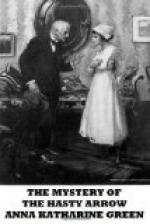He had been through this locker-room in the late afternoon. It was here he had stood to watch the girls file out at the close of their day’s work. The exit for all employees was in one of the corners and out of this Antoinette Duclos would have to pass when it came her turn to leave the building—that is, if she were really in it, as he had every reason to believe.
However, certainty on this point would relieve him from much of his present impatience, and with this end in view he prepared to enter the room again in the hope of spying among the various hats with which the walls were hung the one with whose shape and trimming he was so well acquainted.
But promising as this attempt looked, it was destined to immediate failure. The room was not empty. He could hear girls whispering not a dozen steps away, and anxious as he always was not to attract any unnecessary attention to himself, he turned his back upon this door and returned to the window from the broad view of which he anticipated so much.
A brilliant scene awaited him. This building, built originally for other purposes, had been hastily reconstructed for its present use in a manner possibly open to criticism but which certainly gave those who worked in it an abundance of light and air. The narrow columns supporting its three stories were so inconspicuous at night when a blaze of electricity dominated the whole, that it presented the appearance of being made entirely of windows. One break and one only he observed in the double row of lights encircling the courtyard. This was in a spot diagonally opposite, where a space of several feet showed a dimness he failed to understand. But as no workers appeared to be there, he passed the matter over as one of no importance.
The task before him looked hopeless. In the first place there were the three floors, with no faces visible above the first one. Then of the long rectangle stretching out before him he could see but two sides, which fact was further complicated by there being as many of the workers’ faces turned toward the outside of the building as toward the court. Yet having determined upon his course, he was bound to see it through.
His position near the corner of the huge rectangle precluded his seeing anyone working at his own end. He was obliged to pass them over. But of those opposite, especially those directly so, he could take easy count. They were all girls of fifteen or so, and could be passed over also without more than a cursory glance. Further on he saw a row of older women, and student as he was of human nature, there were faces among them at which he was tempted to look twice, though once answered his purpose. There was no Madame there.
Continuing his examination, he next encountered the space so unaccountably darkened, and having skipped this, came upon a stretch of benches displaying great activity. Only old hands seemed to be at work in this section. Their method and despatch showed a training which made it useless to look among them for one who had probably never worked before amid the hum of machinery.




